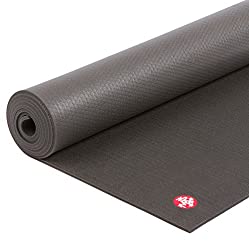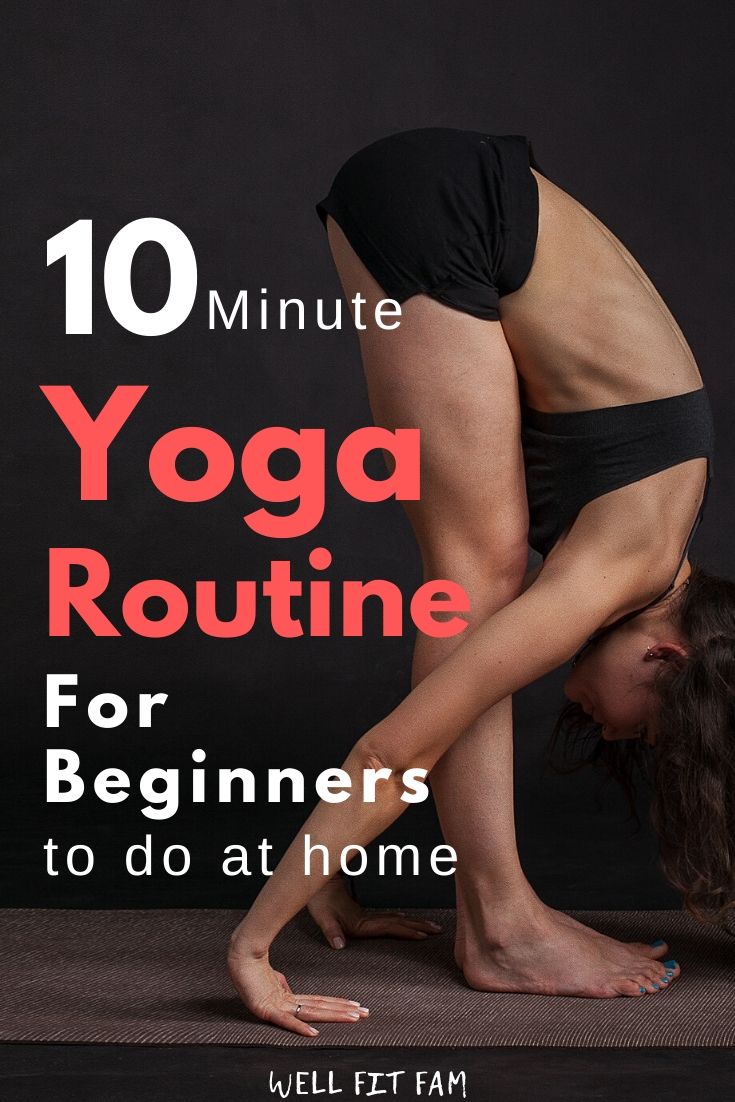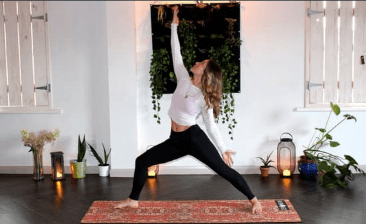Chances are you’re looking for a 10-minute yoga routine for beginners to do at home.
Before you start it’s crucial to actually have the right equipment for yoga. This is why we recommend the Manduka PROLite as the best overall mat or the PIDO yoga mat if you find you get sweaty palms.
Most people know that yoga can help to destress and improve flexibility. But did you know yoga has also been proven to be one of the best ways to strengthen your body AND lose weight?
Before we tried yoga, we used to think it was this woo-woo thing that hippies with flowers in their hair did in a field.
In fact, it’s actually something anyone can do at any time, anywhere.
You’re about to learn a simple 10-minute yoga routine for beginners to use at home, whether yoga is a good type of exercise to lose weight and the most common questions beginners ask when they start yoga.
Top recommended Yoga Mat- Manduka PROLite

If you’re looking for a yoga mat that is versatile to use in any situation, this is one you must consider. It is one of the most durable mats out there so you won’t need to worry about having to replace for the next few years.
The high-density cushion and joint protection mean that it’s suitable for all types of yoga, pilates and general gym work.
This support is perfect for beginners or advanced yogi’s to avoid injuries or feeling pain through the mat on elbows and knees.
Is Yoga Actually A Good Workout?
If you’re like me, the answer to this may actually surprise you.
Certain yoga poses are also great for engaging your core and building muscles.
The style of yoga that you do and the poses (asanas if you’re posh) that you hold are important for building muscles.
For example, child’s pose is a relaxing or recovery position, which can certainly improve flexibility. But poses such as the Warrior’s or chaturanga’s are great ways to build muscle.
Now, you’re probably thinking…
How Does Building Muscles Help To Lose Weight?
Muscles require more energy than fat.
Therefore, when you build muscle your body uses more energy aka increases your metabolism.
This continues all day and long after you finish your yoga routine.
I’m not talking about muscles like this…
No, no, no!
Yoga helps to build lean muscle mass.
This means your body will be building muscle, improving strength and burning fat all at the same time.
But it doesn’t end there…
How Many Calories Does This 10 Minute Yoga Routine For Beginners Burn?
You probably still want to know exactly how many calories are burnt during exercise.
After all, we have it wired in our brains that to lose weight you need to burn more calories than we put in our bodies.
This is a great way for people to understand losing weight in simple terms, but in fact, there is a lot more to it than this as you are about to find out.
Regardless, this is how many calories each exercise burns for a 120 lb person for 10 minutes:
- Hatha (slow) yoga: 34
- Vinyasa/ Flow yoga (the routine below is a Vinyasa): 79
- Running (at 6mph): 80
(You can even try this yourself using online calculators for running or yoga)
So yes, the type of yoga matters if you want to lose weight.
But there really isn’t as much difference compared to endurance activities as most people think.
Other Yoga Benefits To Help You Lose Weight
Did you know yoga actually has a lot of benefits to it?
Here are just a few of the more surprising benefits to yoga:
- Increased muscle strength and tone
- Weight reduction
- Maintaining a balanced metabolism
- Improved athletic performance
Without getting into all the science stuff right now, did you know that yoga reduces your cortisol levels (aka stress levels)?
It’s proven that reducing these levels helps you burn more fat.
Just compare this to a stereotypical exercise for weight loss, such as running… it increases your cortisol levels!
With all of that said, let’s get into this 10-minute yoga routine for beginners…
How to Use This 10 Minute Yoga Routine For Beginners
1. Mountain Pose (Tadasana)
Well-Fit tips:
- Make sure your shoulders do not rise up to your ears
- Spread your toes wide and keep your feet grounded and pushing into the floor
- Do not lock your knees whilst standing straight
- Keep your back and neck straight
2. Upward Hand Salute (Urdhva Hastasana)
Well-Fit tips:
- Spread your toes wide and keep your feet grounded
- Keep your shoulders down, do not let them rise up towards your ears
- Pull your thighs in towards each other
- Keep your core tight
3. Warrior I (Virabhadrasana I)
Well-Fit tips:
- Keep back foot slightly turned it
- Place your hands on your hips to help align your body
- Keep your front leg bent at the knee
- Be careful not to lock your knee on your back leg
4. Warrior II (Virabhadrasana II)
Well-Fit tips:
- Keep your lower body grounded and in the same position as Warrior I
- Maintain normal breath
- Make sure your shoulders stay down and do not come up towards your ears
- Keep your arms strong throughout the position
5. Triangle (Trikonasana)
Well-Fit tips:
- Extend your arm to the sky to open up your body
- If you are unable to reach your ankle, hold on to your shin or just above the knee
- Be careful not to lock your front knee
- Turn your gaze to look at your fingertips to help with balance
6. Extended Side Angle (Utthita Parsvakonasana)
Well-Fit tips:
- If you struggle to touch the floor, you can balance on fingertips or use a block to support
- Keep both heels grounding down on the floor
- Make sure your side body and ribcage is fully open during this posture
- Repeat for the same length of time on each side
7. Upward Hand Salute (Urdhva Hastasana)
Well-Fit tips:
- Spread your toes wide and keep your feet grounded
- Keep your shoulders down, do not let them rise up towards your ears
- Pull your thighs in towards each other
- Keep your core tight
8. Standing Forward Fold (Uttanasana)
Well-Fit tips:
- Keep your back straight, do not arch your back
- If you find the position very intense or have lower back pain, bend your knees slightly to reduce tension on your back
- Practice this position regularly for the most benefit
9. Four-Limbed Staff (Chaturanga Dandasana)
Well-Fit tips:
- Keep your elbows close to your body
- Use a block to support your body if you find this position very intense
- Keep your core engaged
- Do not let your back dip or bend when holding this position
- Hold for 10-30 seconds
10. Cobra (Bhujangasana)
Well-Fit tips:
- Go straight into this position from four-limbed staff pose
- Keep your toes pressing down into the ground
- Make sure your shoulders do not rise up to your ears
- Slowly lift your upper body to avoid pulling any muscles
Repeat The Above Sequence
11. Child’s Pose
Well-Fit tips:
- Choose which variation suits your needs
- Make sure your bottom stays down and rests on your heels
- Touch your forehead to the mat
- Child’s pose can be used whenever you need a break from an intense yoga position or routine
Frequently Asked Questions
Should You Warm Up Before Yoga?
Generally speaking, our muscles always perform better if they have been warmed up before exercise.
As yoga is designed to gradually warm-up and stretch the body there is no need to do a ‘serious’ warm-up, however, some gentle stretching and mobility exercises are advised before you start, especially if you are feeling a little tight or are new to yoga.
How Often Should You Practice Yoga?
There is no set rule for how often you should practice.
You will feel the benefit from just one-hour yoga session a week.
It is recommended to practice 2-3 times a week for an hour each time. But at Well Fit Fam we recommend forming a realistic habit that works for you.
Daily practice is also extremely beneficial so try 10-20 minutes every day to really see some great benefits. Plus finding 10 minutes a day is much easier for most people than finding an hour 3 times a week!
Do You Need Rest Days?
Rest days are certainly an important part of a well-rounded fitness routine.
Ultimately you need to listen to your body. If you are feeling sore from a particularly intense yoga workout then it is a good idea to take a rest day and try something else like going for a slow walk or doing some gentle stretching at home.
When Is The Best Time Of Day To Practice Yoga
Our recommendation is to practice yoga in the morning or early evening.
It has many benefits for the body but also the mind and will leave you feeling refreshed, focused and ready for the day ahead when practised in the morning. If you are practising in the early evening you may decide to complete a more relaxed routine including lots of long holding positions.
It is important to remember that practising yoga at any time of the day will benefit your mind and body so just go for it!
10 Minute Yoga Routine For Beginners Summary
There you have it, a hassle-free 10-minute yoga routine for beginners to do at home.
You can repeat the sequence of poses as many times as you like but we recommend at least twice to really feel the benefits.
If you enjoyed this routine, share it and pin it so others can enjoy it too!


P.S. Check out 23 yoga poses to lose weight quickly if you are looking for another yoga workout.

